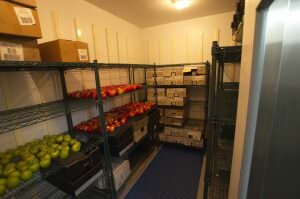Last updated January 11, 2018 at 1:24 pm
If it’s minus 30°C outside, why do they need refrigeration mechanics in Antarctica?
“Yeah, it’s a bit of a funny one,” says Wayne Donaldson, current refrigeration mechanic and electrician based at Casey research station in Antarctica.
“People always say isn’t it cold enough? But different things need to be kept at different temperatures for different reasons. Although Antarctica is cold, the temperature can fluctuate quite a bit.”
At Casey station, managed by the Australian Antarctic Division, you’d find Wayne working on refrigeration systems to keep food fresh, control the temperature of medical supplies, and store scientific samples.

Wayne Donaldson at Casey Station. Image: Australian Antarctic Division
Keeping food fresh
Food supplies only come in once a year, and keeping food fresh as long as possible is the goal.
“Food is a big part of the social fabric of the place,” says David Waterhouse, the Australian Antarctic Division’s Antarctic Infrastructure Manager. “We make sure we get good fresh produce that’s had a carefully controlled cold storage supply chain straight from the farm so we can get it to Antarctica in the best shape.”
Once it arrives, it’s not just a matter of keeping it cold in the Antarctic air. They may have recently uncovered a well-preserved 100-year-old fruitcake in Antarctica, but fresh fruit and vegetables need controlled humidity with no fluctuations in temperature.
“If you leave lettuce and tomatoes outside they’ll explode,” points out Wayne.
They’ve recently built better food storage facilities at Davis station, so that foods can be kept separate. If you store apples with potatoes, ethylene gas released from the ripening apples can speed up the rot of potatoes, so storing in their own areas keeps everything fresher longer.
No matter how good the refrigeration though, eventually fresh food will turn.
David Waterhouse remembers a particularly awful job that everyone would take turns at when he was down on station.
“We called it cabbage duty – you take the cabbages out of the freezer, peel the outer layer of slime, wash them and put them back. Portions of coleslaw got progressively smaller over winter, but it worked!”
Keeping science samples safe
Keeping the freezers on is also a job with a huge responsibility when it comes to making sure the science runs smoothly.
Scientific expeditions to Antarctica can cost of millions of dollars and take years of planning, and while some analysis is done on site, bringing samples back to Australia is a critical part of the scientific process.
“Some of it’s just dirt or moss or whatnot, but at the end of the day all their samples are in a fridge. I’m the only one here to keep it all running,” says Wayne.
It can get tense when things go wrong, as they always do. One time the ‘science freezer’ broke down. “It was chock a block of ice cores,” says Wayne, “It all went pear shaped and it took a week to fix it up.”
Mechanics of any sort in Antarctica need to be resourceful with what they have.
“There’s a lot of old stuff here, they’re pretty old stations,” says Wayne, “We have spare parts, but only so much. There’s a whole bunch of retrofitting”.
“Reliability is key,” says David, “If one part fails we have something else that can kick in, or we can move things quickly between facilities if there’s an issue.”
Keeping things cool
How do you keep things cool in Antarctica?
The fridge that stores fresh food like fruit and vegetables and eggs is actually called the warm store, as it needs to heat products up to prevent them from freezing. At Casey station this is run by a reverse-cycle air-conditioner.
Refrigeration at Davis station is not run using a conventional system. Rather, it uses a new glycol-based system that makes use of the cold Antarctic air, providing big savings on power use. Glycol is pumped outside where it cools down, and then this chilled glycol is used as a refrigerant. Using chilled glycol liquid rather than the cold Antarctic air gives much finer control over temperatures.
“If we brought in chilled air we’d lose humidity”, says David, “Antarctic air is very dry so fruit and veggies would dry out”.
There’s a traditional chiller system that kicks in when summer temperatures push up to above zero. This system strikes the balance between simplicity and maintainability, to be as energy efficient as possible.
Working in Antarctica
The Australian Antarctic Division has an annual recruitment drive as they send out a new workforce every season.
“I always thought it would be a cool job,” says Wayne, “it’s the next closest thing to being able to go somewhere like the moon.”
It wasn’t until he spoke to a friend of a friend at a bucks’ party who’d actually worked in Antarctica that he thought about actually applying.
“He’d been down twice and was telling me how cool it is, I had a look at the website and sure enough there’s an electrician job and I thought why not apply?”
The selection process is “pretty full on but worth it and very cool. It’s definitely not a normal job.”
Applicants can expect to go through a rigorous written application first, before technical interviews are conducted.
“We try to get a mix of people who have been before and new people who can bring in new ideas from industry and get us exposed to practices from other areas,” says David, whose role includes overseeing the recruitment of tradespeople for expeditions.
Beyond being technically capable, living in Antarctica throws up a whole new set of challenges. Applicants who progress through the first rounds will end up in a Selection Centre, where a small group of potential expeditioners will be together for a 24-hour period to assess some of the other skills you need for life in Antarctica: adaptability, patience, flexibility, and your ability to get on with others when you’re living in close quarters for an extended period of time.
Last year there were 24 applications for refrigeration mechanic and the Australian Antarctic Division employed one. The ratio varies across trade areas and from year to year. In 2017 there were 180 applications for electrician positions, and 10 were employed.
“You’ve got to be in it to win it, is the advice I give to anyone who is interested in applying,” says David.
“It’s a great gig,” says Wayne. “There’s such a big variety of work, there’s always something to learn and that’s the great thing about it.”
“Out of seven electricians I’m the only one that’s a Fridgey, so whenever I get called up to do something everyone else is keen to come along and learn too.”
“There’s people working here from all sorts of trades, and as a team we’re expected to know how to fix everything.”
While Wayne says it’s not always easy being a ‘Fridgey’ in Antarctica, it’s an incredibly worthwhile experience.
“There’s days when there’s cyclone winds or a blizzard on, but then there’s days where it’s plus 2 degrees and blue skies and icebergs floating in the ocean. Those days you stop and look out and think holy moly this is unreal.”
Applications are open now for refrigeration mechanics, and a range of other jobs, with the Australian Antarctic Division. Applications close 24 January. For more details visit: antarctica.gov.au/jobs/antarctica































































































































































































































































































































































































































































































